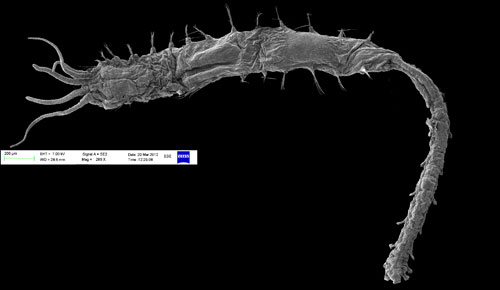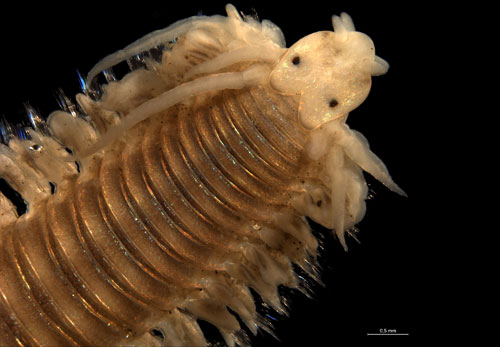
Contact
Biological mapping
Børge Holte
+47 77 60 97 53
Geological mapping
Terje Thorsnes
+47 73 90 42 75
Bathymetry
Hanne Hodnesdal
+47 51 85 88 23
Information officer
Beate Hoddevik Sunnset
+47 55 23 85 16

Published: 26.06.2012 Updated: 03.10.2022

Ampharete n.sp. (photo: Katrine Kongshavn, UiB).
Most of the new species were collected from the continental slope and in the deep-water basins of the Norwegian Sea, where sub-zero temperatures occur deeper than 800 metres and downwards to depths of around 4000 m. A group of polychete experts from various Norwegian research institutes are poised for the exciting but demanding work of describing the species scientifically. Several close relatives of these species are known from the shallow coastal and offshore Norwegian waters. It is a laborious but necessary work to clarify the differences between these and their newly discovered cousins to get a full overview of biodiversity in the Norwegian seas.
One of the species found in the MAREANO material is the polychaete Ophelina opistobranchiata, up to 1 cm in length, which was described over a century ago and has not been found since. Now it has turned up in the deep waters off the Lofoten Islands. Researchers from the University Museum in Bergen, NTNU Trondheim Science Museum and the Norwegian Institute for Water Research have just published a revised description of the species.

Ophelina opistobranchiata (photo: Katrine Kongshavn, UiB).
The new material from MAREANO has given researchers the opportunity to apply modern techniques that have provided a better basis to clarify the relationships between species. For example, genetic analyses and so-called DNA barcoding have been used. DNA barcoding is now conducted on many species to supplement the traditional descriptions of species based on morphological characteristics. New species to science have been found in several family groups of polychaetes, including Maldanidae, Ampharetidae, Flabelligeridae and Scalibregmidae. The work to describe these species scientifically in international scientific journals is being launched these days.
The high quality of the material, where microscopic characteristics of individual species are intact, provides the basis for reliable species identification. At the same time the material is well suited for genetic analysis. Today, international databases for future storage of DNA-information are being built up. Each species has its particular "DNA barcode" which may be used in the future, when new tools for species identification become available. Effective and precise methods for species identification of these marine organisms play a key role in the development of new drugs and chemicals of interest for medical and industrial research.
After the species identifications undertaken by the MAREANO biologists, the material is routinely prepared and transferred to the collections of the University Museum in Bergen, where samples are further used in biosystematics and related research. Recently, a partnership has been established between the Norwegian Biodiversity Information Centre, MAREANO and Norwegian researchers within the framework of the "Norwegian Barcode of Life" (NORBOL) who will work specifically with DNA barcoding of marine invertebrates collected by MAREANO.
Polychaetes belong to the annelid worms and comprise about 11 000 described species. They can be found in most marine environments and at all depths. Polychaetes are well-known to occur within bottom sediments or between other sessile animals on the seabed. Often, the MAREANO samples contain up to 50 % polychaetes measured by number of individuals.
Most species are from a few millimeters to a few centimeters wide and are therefore difficult to spot. But they are very numerous and thus play an important role in the seabed ecosystems. If you want to see polychaetes without using heavy sampling equipment you may simply wade into the sea and take up a handful of bottom mud, and then take a close and careful look between the sand particles by using a magnifying glass.
Polychaetes feed in very different ways. Many eat the mud or silt on the seabed, which contains a small amount of organic material that can be utilized. Others have developed a crown net that rises out of the sediment surface and collects small food particles that drift with the water currents. Some are predators, capturing other small animals by using specialized grabbing organs such as the catching stomach (proboscis), equipped with sharp teeths, that is thrown out to grab the prey.
Polychaetes have a very important role as food for bottom fish, and they also help to maintain animal life within bottom sediments through making holes beneath the surface, where oxygen-rich seawater penetrates. Their fecal products serve as a food chamber for bacteria that can break down organic matter, enhancing the recycling of nutrients in both the sediments and the overlaying water layer. Thus, polychaetes contribute significantly to rich and productive benthic communities.
Typical for the polycheate family Maldanidae, of which several of the new MAREANO species belong to, is that they bury their head deep into the bottom sediment (up to 10-20 cm below the sediment surface), leaving their droppings on the sediment surface, where bacteria and other groups of animals feed on the waste. This activity leads to a capsizing of sediments, bringing otherwise hidden organic material up to the sediment surface, and keeping the sediments healthy and relatively oxygen rich. This illustrates the ecological role of polychaetes, not only for the bottom ecology, but also for the benefit of the marine ecosystem as a whole.

Maldanidae (photo: Jon Kongsrud, UiB).

Phyllodoce sp. (photo: Katrine Kongshavn, UiB).